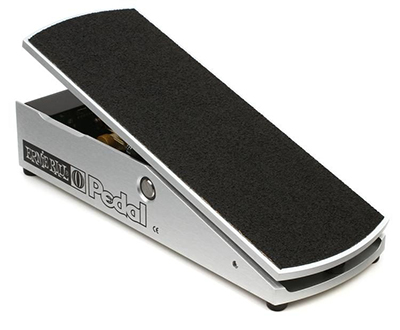
By Ed Malaker
Posted 03/28/2019
Dynamics and gain are the most basic of guitar effects. They deal with Volume, and they’re designed to help control how loud or soft your signal is. The Volume control built into your guitar might not seem like it, but it fits into this category. What might seem like even less of a fit in this category, is your guitar’s Tone control, but believe it or not, it actually adjusts the Volume of your guitar’s high-end frequencies.
Volume Pedal
The Volume pedal is for adjusting the loudness and softness of your guitar with your foot. This pedal works exactly like the one on the guitar – i.e., it’s usually not meant to Boost the signal, just turn down what is there. It’s a very simple design and often the pedal does not even need power. Take a look at the Ernie Ball VP Jr. P06180, or the Fender FVP-1 Volume Pedal.
Gain Boost
The Gain Boost Effect is meant to boost your signal and the effect is Amplification. In pedal form, the Gain Boost might be used to boost your signal when using a lot of pedals, a long cable, if you want to get a little louder during a solo, or you want to drive your amp a little harder to get a better overdrive. A preamp and your amp are a Gain Boost. Gain Boost is by far the most common effect on this list because there are Gain Boost stages everywhere, including in many of the other effects. The amplification (in analog) is usually accomplished with one or more transistors or tubes. Take a look at the J Rockett Archer Clean Boost Pedal, or the BBE Boosta Grande Clean Boost.
Compressor/Expander
The Compressor/Expander Effect is an automatic Gain Control. It has internal circuits that (1) set a Threshold and (2) detect the Volume level of a signal. Depending on how the Compressor is set, it might turn down the Gain once a signal passes a Threshold, or it might turn up the Gain if it falls below a Threshold, or both. Compressors are often used to keep a signal more even for recording. It can also be a great tool for players who have a hard time controlling their dynamics. Compressors are pretty standard equipment, and they are used by modern musicians on almost every instrument. A Compressor is meant to “compress” the dynamic range, so it will turn down loud parts and turn up quiet parts. An Expander is meant to “expand” the dynamic range, so it will turn down quiet parts and turn up loud parts. In practice we use a Compressor much more often than we do an Expander. Another benefit to a Compressor is that it increases sustain by turning up the volume to compensate, as the signal fades out. Take a look at the Donner Ultimate Comp, or the Boss CS-3 Compression Sustainer pedal.
Limiter
A limiter is actually just a type of Compressor with extreme settings. With a Limiter you set a Max Threshold and when a signal reaches the Max Threshold the Limiter turns down the volume, attempting to prevent the signal from going beyond the threshold at all costs. This is different from a Compressor only because a Compressor uses softer settings to make the sound more natural (it might turn down the volume 2db for every 3db a signal is over the threshold). You use a Limiter if a signal cannot go beyond a certain level, even if it means sounding unnatural. It is very helpful for protecting equipment from loud spikes in volume or feedback, and as such is more of a tool than an effect. Take a look at the Behringer Compressor/Limiter CL9, or Carl Martin Compressor/Limiter.
Noise Gate
A Noise Gate is also a type of Compressor. Actually, it is the only example of an Expander that I can think of that we use as guitarists. A Noise Gate sets a Threshold and when a signal goes below that Threshold the Noise Gate slams shut and turns the Volume all the way off. When a signal once again reaches the Threshold the Gate opens and sound is allowed to flow again. For guitarists, the use for a Noise Gate is to eliminate noise when we are not playing. Any time that we are not playing (in between songs) the gate slams shut and turns off any static or buzzing. Since we can now go from complete silence to sound, instead of buzzing to sound, we have expanded the dynamic range of our guitar. Take a look at the CNZ Audio Noise Gate, or the MXR Noise Clamp.
Talk Box
The Talk Box is an interesting effect that works by building a small amp with a special speaker inside the pedal. The speaker forces the sound of the guitar through a tube that is taped to a microphone and the end of the tube is inserted into a player’s mouth. The player can then use their mouth to make the guitar sound as if it is talking and the sound is picked up by a microphone. Take a look at the MXR M222 Talk Box, or Dunlop HT1 Heil Talk Box Effects Pedal.
If you’ve found this article helpful, please feel free to share this with your friends on Facebook and Twitter. For more articles on guitar electronics, visit humbuckersoup.com.
